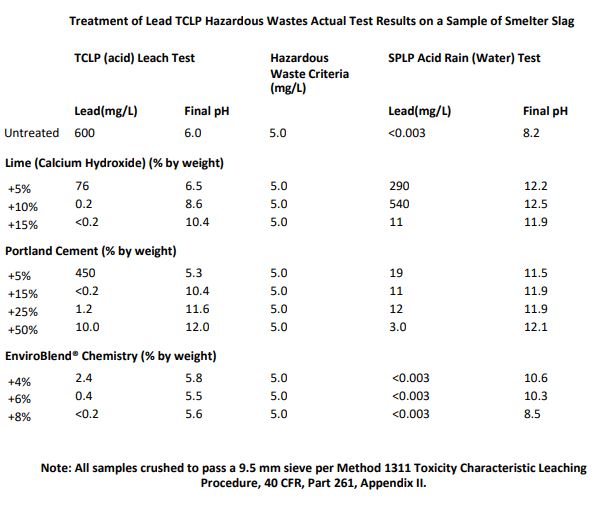Portland Cement and CKD are examples of lime-based treatment technologies that can occasionally pass an initial Toxicity Characteristic Leaching Procedure (TCLP) test. However, actual long-term treatment is at risk.
Once the treated waste is exposed to the environment, a highly alkaline product such as Portland Cement will continue to drive up the pH, often too quickly and irregularly. Because many metals will leach at low and high pHs (on a bell curve), a sudden increase in pH can cause metals to leach over time. Therefore, pH maintenance is imperative to long-term stability.
Portland Cement can have higher dosage and leaching rates.
The use of lime-based technologies can fall significantly short compared with the EnviroBlend chemistry when it comes to dosage rates. Click here for data on the effectiveness of the EnviroBlend chemistry resulting in the very low leaching in both the TCLP (acid) and Synthetic Precipitation Leaching Procedure (SPLP) or “acid rain” tests. Both the lime and Portland Cement treatments are able to sometimes meet the TCLP test at high dosages but they actually increase the amount of lead leaching in the SPLP test.

Case Studies
City of Olympia Police Training Facility Cleanup – Washington
Treatment of lead, enabling the area to be zoned a non-hazardous landfill
Former Industrial Operations Site – Mid Atlantic
Development and implementation of a stabilization approach to treat marsh area formerly used as a shooting range.
Southeast Ferrous Foundry
A ferrous foundry, located in the Southeast, has been using EnviroBlend CS Bulk and super sacks to treat lead and cadmium-contaminated dust from the cupola furnace for over 15 years. EnviroBlend is added in-line [...]



